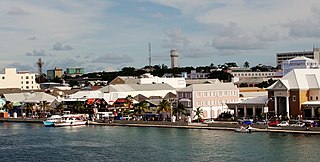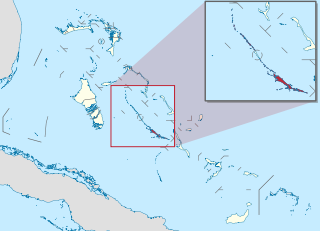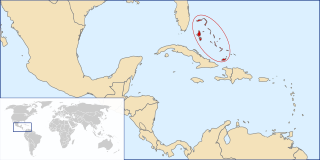Related Research Articles

The Bahamas, officially the Commonwealth of The Bahamas, is a country in North America. It is an island country within the Lucayan Archipelago of the West Indies in the Atlantic Ocean. It contains 97% of the Lucayan Archipelago's land area and 88% of its population. The archipelagic state consists of more than 3,000 islands, cays, and islets in the Atlantic Ocean, and is located north of Cuba and northwest of the island of Hispaniola and the Turks and Caicos Islands, southeast of the U.S. state of Florida, and east of the Florida Keys. The capital is Nassau on the island of New Providence. The Royal Bahamas Defence Force describes The Bahamas' territory as encompassing 470,000 km2 (180,000 sq mi) of ocean space.

Nassau is the capital and largest city of The Bahamas. It is located on the island of New Providence, which had a population of 246,329 in 2010, or just over 70% of the entire population of The Bahamas. As of April 2023, the preliminary results of the 2022 census of the Bahamas reported a population of 296,522 for New Providence, 74.26% of the country's population. Nassau is commonly defined as a primate city, dwarfing all other towns in the country. It is the centre of commerce, education, law, administration, and media of the country.

The Turks and Caicos Islands are a British Overseas Territory consisting of the larger Caicos Islands and smaller Turks Islands, two groups of tropical islands in the Lucayan Archipelago of the Atlantic Ocean and northern West Indies. They are known primarily for tourism and as an offshore financial centre. The resident population in 2023 was estimated by The World Factbook at 59,367, making it the third-largest of the British overseas territories by population. However, according to a Department of Statistics estimate in 2022, the population was 47,720.

The earliest arrival of people in the islands now known as The Bahamas was in the first millennium AD. The first inhabitants of the islands were the Lucayans, an Arawakan language-speaking Taino people, who arrived between about 500 and 800 AD from other islands of the Caribbean.
The Lucayan people were the original residents of The Bahamas and the Turks and Caicos Islands before the European colonisation of the Americas. They were a branch of the Taínos who inhabited most of the Caribbean islands at the time. The Lucayans were the first Indigenous Americans encountered by Christopher Columbus. Shortly after contact, the Spanish kidnapped and enslaved Lucayans, with the displacement culminating in the complete eradication of the Lucayan people from the Bahamas by 1520.

New Providence is the most populous island in the Bahamas, containing more than 70% of the total population. On the eastern side of the island is the national capital city of Nassau; it had a population of 246,329 at the 2010 Census; the latest estimate (2016) is 274,400.

Andros Island is an archipelago within The Bahamas, the largest of the Bahamian Islands. Politically considered a single island, Andros in total has an area greater than all the other 700 Bahamian islands combined. The land area of Andros consists of hundreds of small islets and cays connected by mangrove estuaries and tidal swamplands, together with three major islands: North Andros, Mangrove Cay, and South Andros. The three main islands are separated by bights, estuaries that trifurcate the island from east to west. It is 167 kilometres (104 mi) long by 64 km (40 mi) wide at the widest point.

The Abaco Islands lie in the northern Bahamas, about 193 miles east of Miami, Florida. The main islands are Great Abaco and Little Abaco, which is just west of Great Abaco's northern tip. There are several smaller barrier cays, of which the northernmost are Walker's Cay and its sister island Grand Cay. To the south, the next inhabited islands are Spanish Cay and Green Turtle Cay, with its settlement of New Plymouth, Great Guana Cay, private Scotland Cay, Man-O-War Cay, and Elbow Cay, with its settlement of Hope Town. Southernmost are Tilloo Cay and Lubbers Quarters. Also of note off Abaco's western shore is Gorda Cay, now a Disney-owned island and cruise ship stop renamed Castaway Cay. Also in the vicinity is Moore's Island. On the Big Island of Abaco is Marsh Harbour, the Abacos' commercial hub and the Bahamas' third-largest city, plus the resort area of Treasure Cay. Both have airports. A few mainland settlements of significance are Coopers Town and Fox Town in the north and Cherokee and Sandy Point in the south. Administratively, the Abaco Islands constitute seven of the 31 Local Government Districts of the Bahamas: Grand Cay, North Abaco, Green Turtle Cay, Central Abaco, South Abaco, Moore's Island, and Hope Town.

Exuma is a district of The Bahamas, consisting of over 365 islands and cays.

The Out Islands are the islands that make up the Bahamas with the exception of New Providence Island, where the capital and largest city, Nassau, is located, and Grand Bahama Island, where Freeport is located. The Abaco Islands and Eleuthera islands are among the Out Islands.
Bahamian Americans are an ethnic group of Caribbean Americans of Bahamian ancestry. There are an estimated 56,797 people of Bahamian ancestry living in the US as of 2019.
Conch was originally a slang term for Bahamians of European descent.
Bahamian culture is a hybrid of African, European, and other cultures.

Spanish Wells is a district of the Bahamas. The settlement consists of a medium-sized town on the island of St. George's Cay 610 m (2,000 ft) wide by 2,860 m (9,380 ft) long, located approximately 500 m (1,600 ft) off the northern tip of Eleuthera island. According to the 2022 census, it has a population of 1,608 residents.
The Bluff very often refers to a settlement on North Eleuthera, Bahamas. But there are three Bahamian communities having 'Bluff' in their name.

The following outline is provided as an overview of and topical guide to The Bahamas:

The following is an alphabetical list of topics related to the Commonwealth of The Bahamas.
The Bahamas is a net importer of food, importing almost 90% of its food supply. Of food imports, 80% are from the United States.
Afro-Bahamians are an ethnicity originating in The Bahamas of predominantly or partial native African descent. They are descendants of various African ethnic groups, many associated with the Bight of Biafra, kingdoms, the Oyo Empire, and the Kingdom of Kongo. According to the 2010 census, 92.7% of The Bahamas' population identifies as mixed African descent.
Bahamian nationality law is regulated by the 1973 Constitution of the Commonwealth of The Bahamas, as amended; The Bahamas Nationality Act; The Bahamas Immigration Act; and various British Nationality laws. These laws determine who is, or is eligible to be, a national of The Bahamas. Bahamian nationality is typically obtained either on the principle of jus soli, i.e. by birth in The Bahamas; or under the rules of jus sanguinis, i.e. by birth abroad to a father with Bahamian nationality. It can also be granted to persons with an affiliation to the country, or to a permanent resident who has lived in the country for a given period of time through naturalisation. There is currently no program in The Bahamas for citizenship by investment. Nationality establishes one's international identity as a member of a sovereign nation. Though it is not synonymous with citizenship, rights granted under domestic law for domestic purposes, the United Kingdom, and thus the commonwealth, has traditionally used the words interchangeably.
References
- ↑ What Is The Ethnic Composition Of The Bahamas?
- ↑ The Commonwealth of the Bahamas (August 2012). "2010 Census of Population and Housing" (PDF). pp. 10 and 82.
In 1722 when the first official census of the Bahamas was taken, 74% of the population was European or native British and 26% was African or mixed. Three centuries later, and according to the 99% response rate obtained from the race question on the 2010 Census questionnaire, 90.6% of the population identified themselves as being Afro-Bahamian, about five percent (4.7%) Euro-Bahamian and two percent (2%) of a mixed race (African and European) and (1%) other races and (1%) not stated.
- ↑ "The World Factbook — Central Intelligence Agency". www.cia.gov.
- ↑ Foster, Charles C. 1991. Conchtown USA, with Folk songs & tales collected by Veonica Huss. Boca Raton, Florida: Florida Atlantic University Press. ISBN 0-8130-1042-X
- ↑ Albury, Paul (1975). The Story of the Bahamas. MacMillan Caribbean. pp. 21–33, 41–51. ISBN 0-333-17131-4.
- ↑ Johnson, Howard. (1996) (1996). The Bahamas from Slavery to Servitude, 1783–1933. University Press of Florida. pp. 3–4. ISBN 0-8130-1858-7.
{{cite book}}: CS1 maint: numeric names: authors list (link) - ↑ Turner, Grace S. R. (2013). An Allegory fior Life: An 18th century African-influenced cemetery landscape, Nassau, Bahamas (PDF) (PhD). The College of William and Mary. pp. 20, 24–25.
- ↑ Craton, Michael J. (1986). Settlements in the Americas: Cross-cultural Perspectives. University of Delaware Press. p. 252. ISBN 978-0-87413-411-7 . Retrieved 6 November 2020.
- ↑ "Commonwealth of the Bahamas" (PDF). University of Kentucky College of Education . Retrieved 4 December 2021.
- ↑ Crowley, Daniel (2021). I Could Talk Old-Story Good: Creativity in Bahamian Folklore. University of California Press. p. 9. ISBN 978-0520338289.
- ↑ "Department of Statistics of the Bahamas" (PDF). bahamas.gov.bs. Retrieved 30 March 2022.
- ↑ "Department of Statistics of the Bahamas" (PDF). bahamas.gov.bs. Retrieved 30 March 2022.
- ↑ "Department of Statistics of the Bahamas" (PDF). bahamas.gov.bs. Retrieved 30 March 2022.